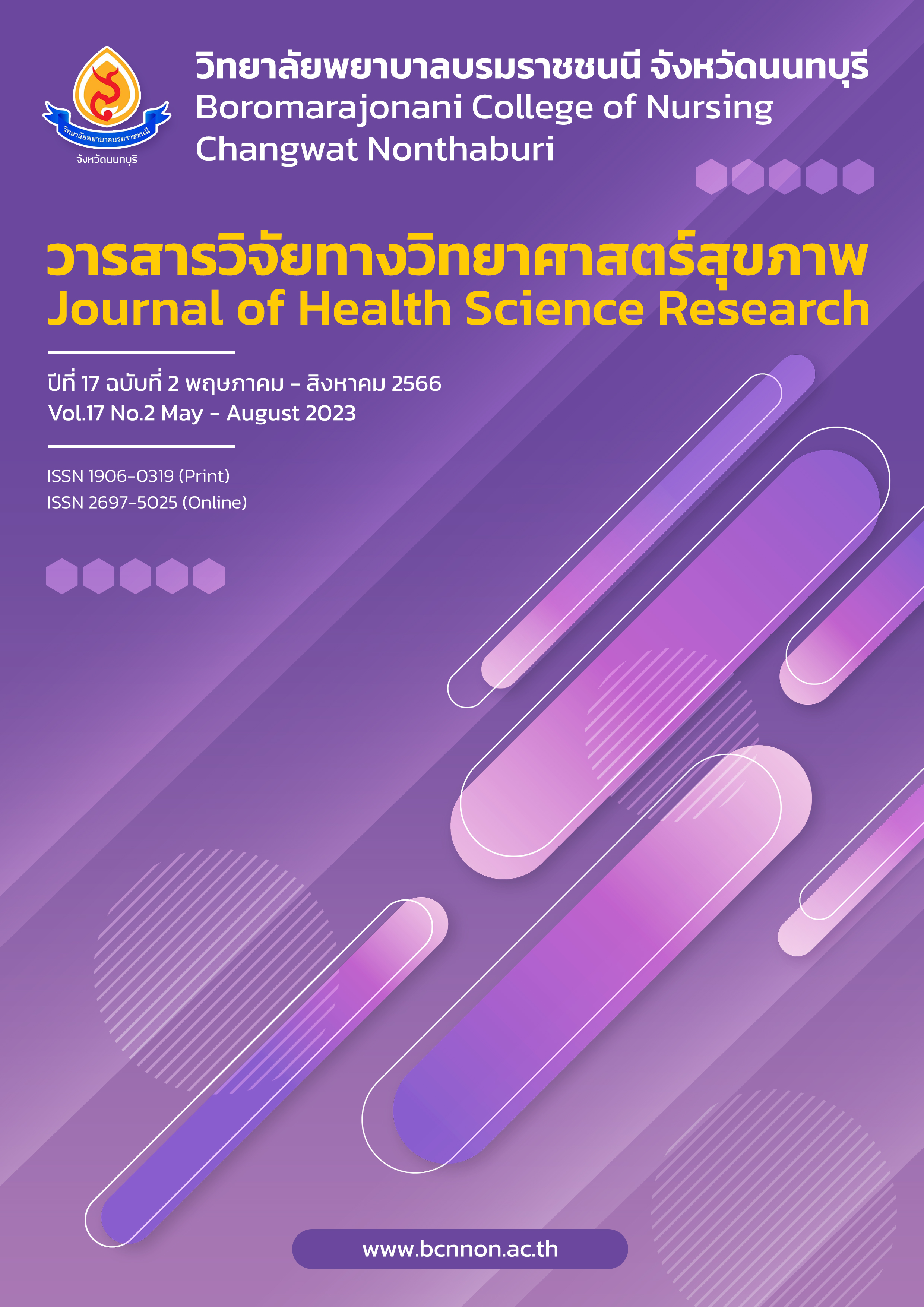ผลของการใช้เครือข่ายระบบการดูแลฟื้นฟูสมรรถภาพผู้ป่วยหลอดเลือดสมองระยะกลางในเขตพื้นที่โรงพยาบาลบางละมุง จังหวัดชลบุรี
Main Article Content
บทคัดย่อ
บทนำ : ผู้ป่วยโรคหลอดเลือดสมองที่ไม่ได้รับการฟื้นฟูสมรรถภาพอย่างต่อเนื่องในระยะเวลาที่เหมาะสมอาจทำให้ความสามารถในการช่วยเหลือตนเองลดลงจนกลายเป็นผู้ป่วยติดเตียง จึงจำเป็นต้องได้รับการดูแลจากสหสาขาวิชาชีพในสถานบริการสุขภาพอย่างต่อเนื่อง
วัตถุประสงค์ : เพื่อศึกษาผลของการใช้เครือข่ายระบบเครือข่ายการดูแลและฟื้นฟูสมรรถภาพผู้ป่วยหลอดเลือดสมองระยะกลางในเขตพื้นที่โรงพยาบาลบางละมุง จ.ชลบุรี
วิธีการวิจัย : การวิจัยแบบกึ่งทดลองแบบกลุ่มเดียววัดก่อนและหลังการทดลอง ตัวอย่าง คือ ผู้ป่วยโรคหลอดเลือดสมองระยะฟื้นฟูที่มารักษาในโรงพยาบาลบางละมุง จ.ชลบุรี จำนวน 58 ราย สุ่มแบบเจาะจง เครื่องมือที่ใช้ ได้แก่ ระบบเครือข่ายดูแลผู้ป่วยโรคหลอดเลือดสมอง แบบสอบถามการปฏิบัติกิจวัตรประจำวัน แบบประเมินคุณภาพชีวิต แบบประเมินภาวะวิตกกังวลและซึมเศร้า และแบบประเมินความพึงพอใจได้ค่า IOC ระหว่าง .67-1.00 ได้ค่าสัมประสิทธิ์แอลฟ่าของครอนบาคเท่ากับ .91 วิเคราะห์ข้อมูลด้วยสถิติเชิงพรรณนา และสถิติ Wilcoxon signed rank test
ผลการวิจัย : หลังเข้าร่วมพัฒนาระบบ ผู้ป่วยมีคะแนนความสามารถในการปฏิบัติกิจวัตรประจำวัน และคะแนนคุณภาพชีวิตเพิ่มขึ้น ในขณะที่คะแนนความวิตกกังวลและภาวะซึมเศร้าลดลง เมื่อเทียบกับ 1 สัปดาห์, 2 สัปดาห์, 4 สัปดาห์ และ 6 เดือน อย่างมีนัยสำคัญทางสถิติที่ระดับ .05, .01 และ .001 นอกจากนี้ผู้ป่วยมีความพึงพอใจต่อการบริการอย่างมีนัยสำคัญทางสถิติที่ระดับ .001 เมื่อเทียบกับเกณฑ์ร้อยละ 80
สรุปผล : เครือข่ายการดูแลผู้ป่วยระหว่างโรงพยาบาลสามารถลดความแออัดในการรับบริการทั้งในลักษณะผู้ป่วยใน ผู้ป่วยนอก อีกทั้งยังเป็นการใช้ทรัพยากรร่วมกันให้เกิดประโยชน์สูงสุด
Downloads
Article Details

อนุญาตภายใต้เงื่อนไข Creative Commons Attribution-NonCommercial-NoDerivatives 4.0 International License.
บทความที่ได้รับการตีพิมพ์เป็นลิขสิทธิ์ของวิทยาลัยพยาบาลบรมราชชนนี จังหวัดนนทบุรี
ข้อความที่ปรากฏในบทความแต่ละเรื่องในวารสารวิชาการเล่มนี้เป็นความคิดเห็นส่วนตัวของผู้เขียนแต่ละท่านไม่เกี่ยวข้องกับวิทยาลัยพยาบาลบรมราชชนนี จังหวัดนนทบุรี และคณาจารย์ท่านอื่น ในวิทยาลัยฯ แต่อย่างใด ความรับผิดชอบองค์ประกอบทั้งหมดของบทความแต่ละเรื่องเป็นของผู้เขียนแต่ละท่าน หากมีความผิดพลาดใด ๆ ผู้เขียนแต่ละท่านจะรับผิดชอบบทความของตนเองแต่ผู้เดียว
เอกสารอ้างอิง
GBD 2019 Stroke Collaborators. Global, regional, and national burden of stroke and its risk factors, 1990-2019: a systematic analysis for the Global Burden of Disease Study 2019. Lancet Neurol. 2021;20(10): 795-820. doi: 10.1016/S1474-4422 (21) 00252-0.
Ding Q, Liu S, Yao Y, Liu H, Cai T, Han L. Global, Regional, and national burden of ischemic stroke,1990-2019. Neurology. 2022;98(3):e279-e290. Doi:101212/WNL. 0000000000013115.
Winstein CJ, Stein J, Arena R, Bates B, Cherney LR, Harvey RL, et al. Guidelines for adult stroke rehabilitation and recovery a guideline for healthcare professionals from the American heart association/ American stroke association. Stroke. 2016;47(6):e98-e169. Doi:10.1161/STR.0 000000000000098.
Powers WJ, Rabinstein AA, Ackerson T, Adeoye OM, Nicholas C. Bambakidis, N.C., et al. Guidelines for the early management of patients with acute ischemic stroke: 2019 update to the 2018 guidelines for the early management of acute ischemic stroke: a guideline for healthcare professionals from the American heart association/American stroke association. Stroke. 2019; 50(12): e344-e481. Doi:org/10.1161/STR.0000000 000000211.
Tieamkao, S. Strock situation. Thai Journal of Neurology. 2021;37(4):54-60. (in Thai).
Chantkran W, Chaisakul J, Rangsin R, Mungthin M, Sokboonyarat B. Prevalence of and factors associated with stroke in hypertensive patients in Thailand from 2014 to 2018: A nationwide cross-sectional study. Scientific reports. 2021;11(17614):1-11. Doi.org.10.1038/s41598-021-96878-4.
Teamkaw S. Stroke situation. Thai Journal of Neurology. 2021;37(4): 54-60. (in Thai).
Grefkes C, Fink GR. Recovery from stroke: current concepts and future perspectives. Neurol Res Pract. 2020;2(17):1-10. doi:10.11 86/s42466-020-00060-6.
Pattapat W. Nursing care of elderly stroke patients in the recovery phase: a case study. Thai Red Cross Nursing Journal. 2021;14(2): 37-49. (in Thai).
Sakulpipatana P. Outcome of subacute post-stroke rehabilitation in outpatient-based VS Home-based. Region 11 Medical Journal. 2021;35(5):1-9. (in Thai).
Rattanachairit W, Chahorm R, Siwina S. Development of intermediate care from hospital to community healthcare network, Roi-Et. Research and Development Health System Journal. 2022;15(2):119-32. (in Thai).
Moonthee W, Monkong S, Sirapo-ngam Y, Leelacharas S. Impact of transitional care programme and family caregivers on stroke patients’s routine activity performance, complication, and satisfaction. Thai Journal of Nursing Council. 2016;31(1)95-110. (in Thai).
Riedel M, Hausleiter J, Martinoff S. Rehabilitation therapy services for stroke patients living at home: Systematic review of randomize trials. Lancet. 2004;363 (9406).352-6. Doi: 10.1016/S0140-6736 (04)15434-2.
Satirangkoon T, Wongsuwansiri S, Kladchompong P. Clinical practice guidelines for intermediate care. Nonthaburi: Nursing division; 2019. (in Thai).
Faul F, Erdfelder E, Lang AG, Buchner A. G*Power 3: A flexible statistical power analysis program for the social, behavioral, and biomedical sciences. Behavior Research Methods. 2007;39(2):175-91.
Cohen J. Statistical power analysis for the behavioral sciences second edition. Mahwah, New Jersey: Lawrence Erlbaum Associates, Publishers; 1988.
National Health Security Office (NHSO). A guide to support the management of the public health long-term care service system for the dependent elderly in the National Health Security System. Bangkok: National Health Security office; 2019. (in Thai).
Pattanaphesaj J. Health-related quality of life measure (EQ-5D-5L): measurement property testing and its preference-based score in Thai population [Dissertation]. Bangkok: Mahidol University; 2014.
Nilchaikovit T, Lortrakul M, Phisansuthideth U. Development of Thai version of hospital anxiety and depression scale in cancer patients. Journal of the Psychiatric association of Thailand. 1996; 41(1):18-30. (in Thai).


